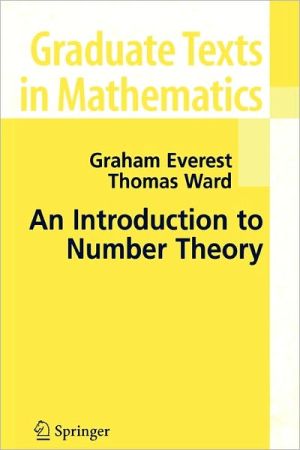

 |

|

The average rating for An Introduction to Number Theory based on 2 reviews is 3.5 stars.
Review # 1 was written on 2017-07-21 00:00:00 Erom Fonz Erom FonzUseful intro reader. Clear examples and plenty of exercises. |
Review # 2 was written on 2021-01-22 00:00:00 Shari Napoleon Shari NapoleonIntroduction to the Practice of Statistics: w Student CD is a very, very basic book on statistics, and though it is a very clear book and neatly presents all useful formulas in the field, it completely ignores any theoretical explanation or proof that could probably be given for the statistical formulas that it attempts to cover. And if it does try to give some background on why certain formulas are devised in the ways they are, it goes off into lengthy texts without any literal mathematical backup in the shape of numbers/formulas/equations. Now, of course, this might be an easy way for some students to learn the very basics of statistics. It's easy to go through, and as I said before, it's a very clear book and it does hold a lot of useful, basic information on statistics. It's accessible to many beginning students, and it presents its content in such a way that even students with a limited mathematical background will probably be able to answer the corresponding statistical exercises correctly. However, its lack of underlying structure and explanations of statistical formulas can lead to problems later on, when the students using this book move on to more advanced classes. (I know it most certainly hindered me in fully understanding just exactly how statistics actually work.) The book does provide the readers with many statistical problems to solve, which are varied and can also be solved via software such as SPSS. There are data sets on the CD too, including a few extra chapters, which seem to do better on the explaining side of things than the book itself. And the book can of course be also used as a work of reference by those already somewhat educated in statistics, since it has a very clear layout, providing an easy way of looking things up. There are, however, two other problems that I have with this book content-wise: first and foremost, this book doesn't recognize the difference between continuous and discrete variables, and it doesn't split its statistical methods up between the two. This can, like I said before, lead to a lot of problems once students encounter more complex problems that need an understanding of the differences between these two types of variables. The second is the lack of methods used for the correction of Type-I errors in multiple comparisons; only Bonferroni is covered, whereas there are many more. There are more things missing from the chapters on both one- and two-way ANOVA, but let's not get too much into that. I would only recommend this book if you're a true beginner of statistics, with limited mathematical background, and prefer lengthy texts without any mathematical proof or explanation of why a formula is the way it is. Be warned, though, this book could cripple you in the future when you start doing more advanced classes - best to use this book in combination with other basic statistics books, to be safe. |
CAN'T FIND WHAT YOU'RE LOOKING FOR? CLICK HERE!!!